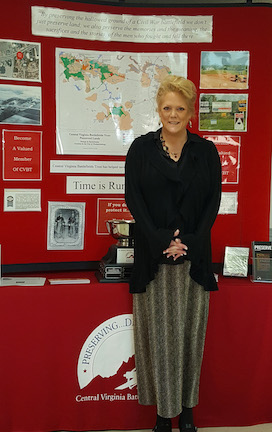A Conversation with CVBT’s Elizabeth Heffernan (part one)
 (part one of three)
(part one of three)
For Women’s History Month, we’ve been talking with several women who work in Civil War public history. This week, we’re pleased to chat with Elizabeth Heffernan, the new executive director of the Central Virginia Battlefields Trust (CVBT). Elizabeth joined CVBT back in December and has spent the last few months learning the ropes. Just last week, CVBT announced a new land acquisition at Spotsylvania Court House.
Chris Mackowski: As we get started, it might be good to just offer readers a little context about CVBT. Could you tell us a little bit about the history of the organization? How is that different from the Civil War Trust?
Elizabeth Heffernan: The mission of Central Virginia Battlefields Trust is to preserve land associated with the four major campaigns in our area: Fredericksburg, Chancellorsville, Wilderness and Spotsylvania. Within a 17-mile radius, this land was witness to more than 100,000 American casualties, making it the costliest battlefield area of its size. Back in 1996, a group of people, from the Fredericksburg area wanted to prevent this sacred Civil War battlefield land from being developed into shopping centers and gas stations, so they decided to form and incorporate CVBT.
We differ from the Civil War Trust because they are a national organization designed to protect battlefield land throughout the United States with battle history from a variety of wartimes. While the Civil War Trust is still very active in preserving our local land, they are not 100% focused on it as is CVBT. We concentrate all our attention on the four Civil War battlefields of the Rappahannock River Valley and have helped save more than 1200 acres of this land.
CM: The organization’s motto is “Preserving dirt and grass.” That seems like a very explicit focus on land. Could you explain that a little bit?
EH: Because, simply put, that is what we are all about: preserving land.
There are many reasons to preserve battlefield land: it benefits our community, country, economy, and our future. For our community and economy, the tourism dollars generated alone can be significant, along with the local jobs that are created. It also serves as an amazingly convenient educational source for schools. Our country benefits because preserved battlefield land becomes a permanent memorial to commemorate the lost lives of our ancestors who died for our freedoms. As for our future, it leaves a lasting record of history for our descendants with the hope that it will not all be forgotten.
CM: You’ve been on the job for CVBT for a couple months now. What have you discovered about the organization?
EH: Many things, but what has mostly stood out to me is the dedication of the people who are involved with CVBT. They are all volunteers and invest large amounts of their spare time to this mission—some even work full time jobs and still manage to juggle in time for CVBT. I guess what is so remarkable to me is that they are not seeking a personal benefit or monetary compensation of any kind. The motivation is selfless and a simple result of their passion for battlefield preservation. If there weren’t people like this today, the sobering proof of our history would eventually vanish from our future.
CM: CVBT is concentrating on growing its membership and visibility right now. How come?
EH: We have over 3,000 names in our database, yet only 450 are active members right now. There are still many donors who support us without becoming members, and that is fine, too. We welcome both, of course, but the consistent support of the membership provides stability in gauging what funds will be available when we need them.
We have long struggled with being confused with the Civil War Trust, so it is my hope that our concentration on visibility will thwart these misconceptions and promote new interest in our cause.
CM: You mentioned “the consistent support of the membership provides stability in gauging what funds will be available.” In other words, you need to know how much money you can depend on before you can plan on what properties you can save, correct? Can you explain that a little more?
EH: Well, the properties that we are interested in saving can take years to cultivate a sale, and yet can become available at the drop of a hat with a very short window to act upon, so it is important that we have at least some predicable funding amid this very unpredictable climate of opportunities.
CM: What are some of the things the organization is doing to “promote new interest in your cause”?
EH: We have initiated an advertising campaign to gain exposure to our brand. We are placing ads in print, submitting articles to many publications, reaching out to local radio services who announce charity events, presenting our exhibit at trade shows, and of course spreading the word verbally any chance we get.
By the way, please feel free to check us out at www.CVBT.org!
————
Tomorrow, Elizabeth will explain what it was about CVBT that brought her to the job—and the path she took to get there.
Proud member of the CVBT. Thanks for all you do.